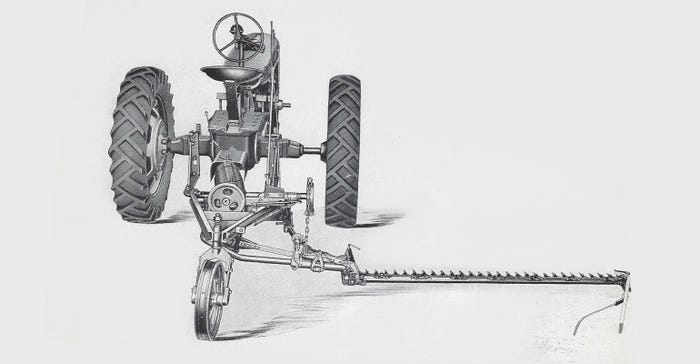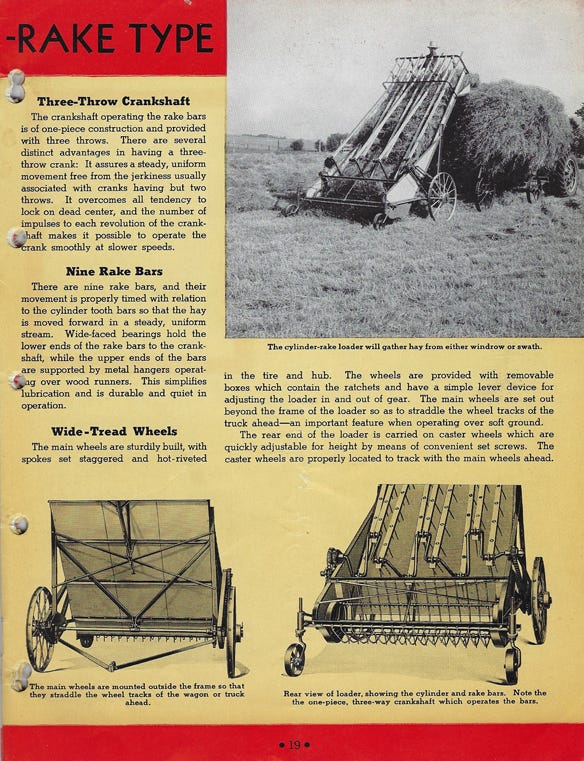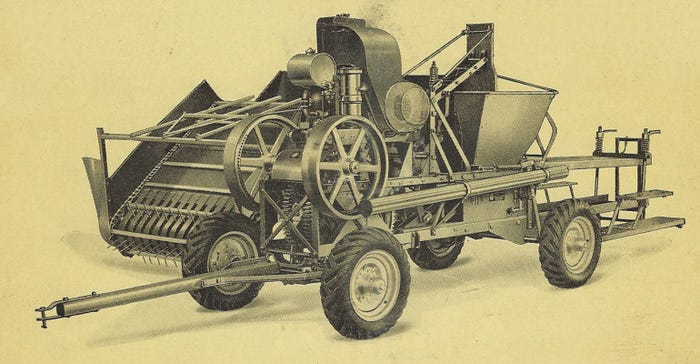June 28, 2018

You may be overwhelmed with the changes in technology in farming today. John Deere just introduced what is essentially a yield monitor app for forage for its newest line of big square balers.
You’re not alone. Change has happened before. If your father or grandfather made hay in the early to mid-1940s, he may have felt the same way. Perhaps he was still pulling hay mowers with horses. He may have been using hay loaders to harvest loose hay. Or maybe he was the innovator who had a baler. It might have had a gas engine, though. The war was raging, affecting what tools were available.
A McCormick-Deering advertising piece from that period makes it obvious that change and turmoil existed even then. Titled “Hay machines — Modern tool for every haying operation,” it covers a broad range of technology.
Hay tools
Here is a closer look inside the brochure:
• McCormick-Deering No. 9 Zerol-Gear Mower. A small tractor and mower grace the cover, but a horse-drawn mower fills the first inside spread. “This two-horse mower with its fully enclosed, ball-bearing transmission is outstanding for light draft, long life and satisfactory performance,” the brochure says.
“Zerol” refers to the type of beveled gears used in the mower. One of the features touted in the brochure is that the draft bracket was adjustable to match the mower to the team of horses.
• 16 Series V-Belt drive mowers for Farmall A, B H and M. There was a 16 Series mower especially designed for each tractor. The 16A and 16B mowers featured 5-foot cutter bars, while the H and M models featured 4-foot cutter bars.
A flywheel shaft turning on tapered roller bearings and powering a V-Belt drove the mower. The brochure claims you could cut at speeds up to 5 miles per hour, and mow up to 40 acres per day.
 TRACTOR MOWERS TOO: The same brochure features two styles of tractor mowers, including this 25-V universal mower driven by a V-Belt.
TRACTOR MOWERS TOO: The same brochure features two styles of tractor mowers, including this 25-V universal mower driven by a V-Belt.

• Hay rakes and tedders. If you still had those horses, the Type M Self-Dump hay rake was for you. Or you might want a six- or eight-fork hay tedder. Some people think hay tedders are a modern invention, but they’ve been around for a long time. Today’s tedders bear little resemblance to horse-drawn tedders.
You could also buy a side-delivery rake to pull with horses or a tractor.

LOOSE HAY DAYS: Obviously many potential customers still loaded loose hay onto wagons with a hay loader. Note the man on top of the wagon, and a small tractor pulling the wagon.

• Hay loaders and balers. The cylinder-rake-type hay loader on steel wheels to load hay loose onto a wagon got a spread in the brochure. There are also spreads on the Model R and Model W green-crop loaders.
After a spread on sweep rakes, there is a final spread on the No. 15 pickup baler. About it’s only resemblance to a modern baler is pneumatic tires. Another spread promotes the No. 15 power baler or bale press, which looks straight out of the steam-engine era. It was meant to sit in place, powered by a gas engine or belt on a tractor, and came with a block-setter attachment. Someone got to drop it into position in the bale chamber at just the right time.
 CRUDE BALER: If your choice was to use this crude machine or handle loose hay, it’s no wonder some people stayed with loose hay. This was IHC’s pickup baler entry in the early 1940s.
CRUDE BALER: If your choice was to use this crude machine or handle loose hay, it’s no wonder some people stayed with loose hay. This was IHC’s pickup baler entry in the early 1940s.

• War effort. The back page of the brochure is devoted to information about the war effort. “Have a garden — buy bonds — save scrap” is one message. A letter from the company stresses the importance of keeping older machines working well since new machines were scarce. One might see it as a thinly veiled pitch to buy genuine IH repair parts for older machines!
Comments? Email [email protected].
You May Also Like




